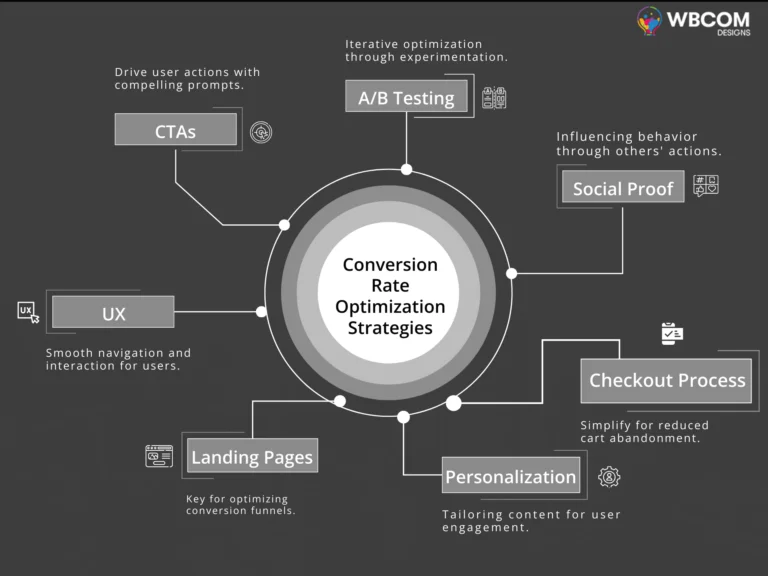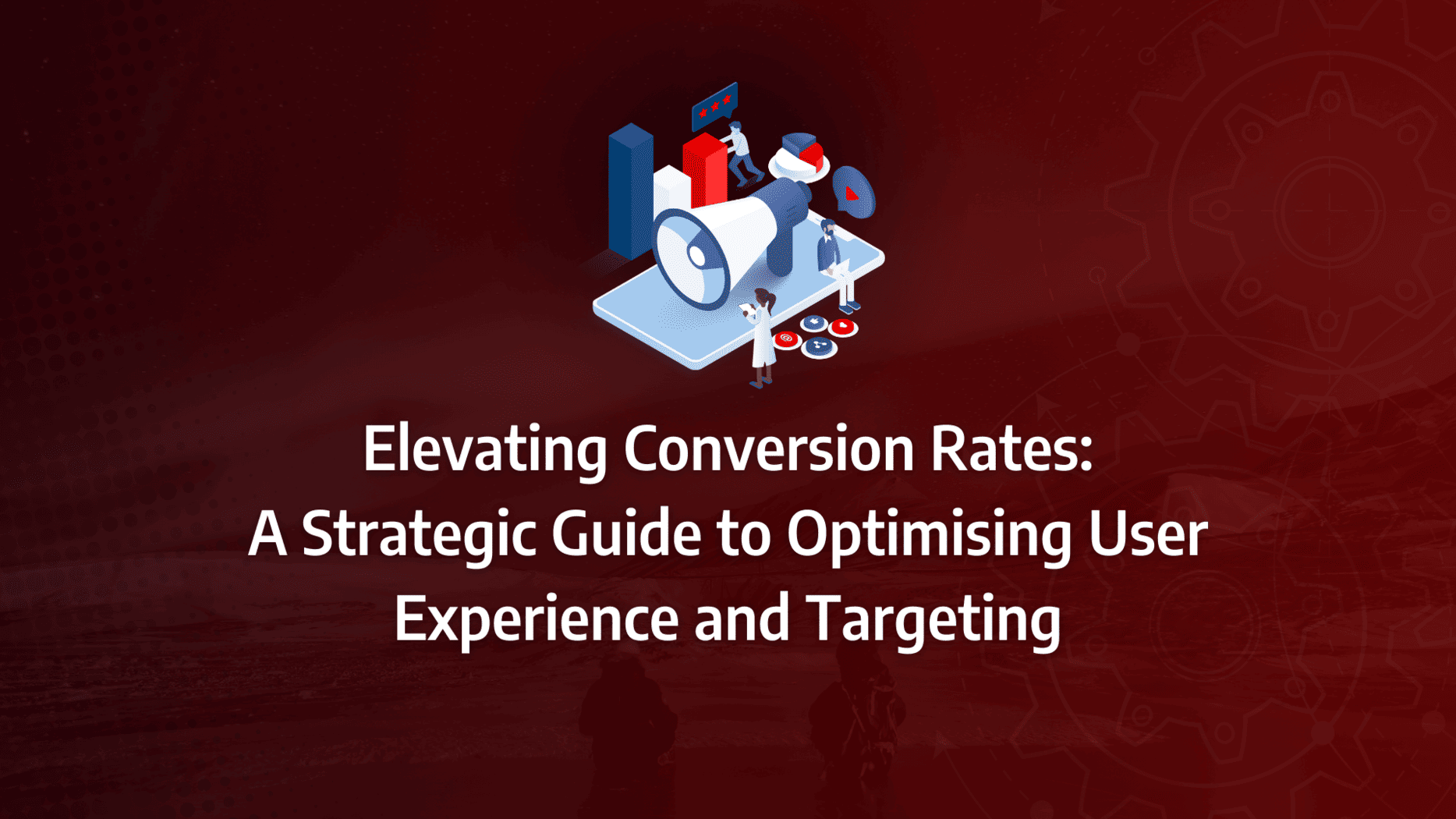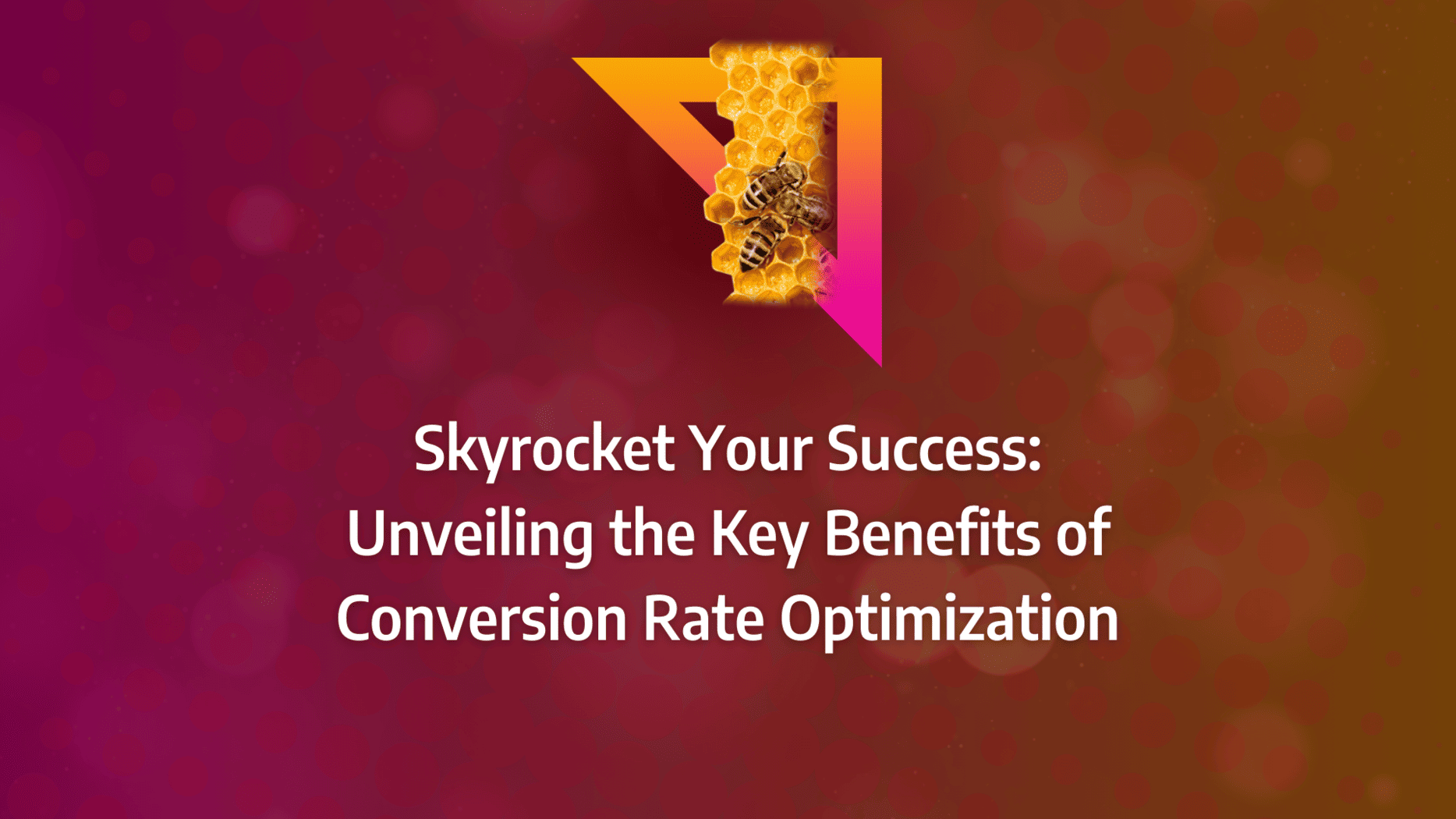Optimising your website’s conversion rate isn’t just an option—it’s a necessity. Yet, many businesses struggle to turn web traffic into tangible results. Whether it’s navigating the complexities of A/B testing or harnessing user behaviour analytics, refining your conversion optimisation process can feel like an uphill battle. But what if you could follow a proven roadmap that simplifies this process?
In this post, we’ll explore step-by-step strategies to enhance your conversion rates. From leveraging cutting-edge tools to avoiding common pitfalls, these insights are designed to help you maximise your web traffic’s potential and drive measurable growth.
By the end of this guide, you’ll have a comprehensive understanding of the strategies that can transform your approach to conversion optimisation—ensuring every visitor interaction counts.
- Prioritise User Experience: A seamless user experience is crucial to improving conversion rates. Focus on refining navigation, load times, and mobile responsiveness to keep visitors engaged.
- Leverage A/B Testing: Regularly conduct A/B testing to identify the most effective elements of your web pages, ensuring your optimisation efforts are data-driven and results-oriented.
- Utilise Advanced Tools: Invest in analytics and heatmapping tools to gain deeper insights into user behaviour, allowing you to make informed decisions on where to optimise.
- Monitor Key Metrics: Track important KPIs, such as bounce rates and time on site, to measure the success of your optimisation strategies and make necessary adjustments.
- Incorporate Customer Feedback: Use customer feedback to refine your conversion optimisation strategies, ensuring that changes align with user expectations and preferences.
- Avoid Common Pitfalls: Be aware of common mistakes, such as overcomplicating the user journey or ignoring mobile optimisation, to ensure your strategies are effective.
- Develop a Cohesive Strategy: Integrate conversion optimisation into your broader marketing strategy to ensure consistency and long-term success.
- Apply Continuous Improvement: Conversion optimisation is an ongoing process—continuously test, refine, and improve your strategies to stay ahead of the competition.
What is the Conversion Optimisation Process?
Understanding Conversion Rate Optimisation (CRO)
The conversion rate optimisation process (CRO) focuses on improving your website or landing page based on visitor behaviour, with the aim of increasing the likelihood of those visitors taking desired actions, such as making a purchase or signing up. This is achieved through techniques like A/B testing and other data-driven methods.
In today’s unpredictable digital landscape, online traffic can be inconsistent and fleeting. If visitors fail to engage with your conversion optimisation strategy on their first visit, the probability of them returning and completing an action diminishes drastically, leading to missed opportunities for your business. The most effective way to counter this is by deploying a well-executed conversion rate optimisation process.
A strong conversion optimisation strategy not only saves time, money, and resources but also unveils new pathways for growth that may have previously been unexplored. Essentially, CRO deepens your understanding of your website’s usability and provides valuable insights into customer behaviour, offering actionable advice on how to refine your user experience (UX) to better align with your business goals.
CRO isn’t a one-off task; it’s an ongoing process of continual learning, testing, and refining. Regrettably, this “continuous improvement” mindset is often overlooked in discussions surrounding conversion rate optimisation and its components, but it remains key to long-term success.
What Matters Most?
From our experience, what often makes the biggest impact in conversion optimisation is aligning business objectives with customer expectations. Clients frequently discover that diving into qualitative research early allows them to pinpoint user behaviours that are otherwise overlooked. We’ve typically seen how emotional motivators play an essential role in B2B decision-making, a point that many underestimate. Furthermore, it’s critical to build a culture of continuous experimentation; fostering a testing mindset across teams often leads to breakthrough insights. Prioritising long-term customer value over short-term metrics will allow you to optimise conversions sustainably while driving business growth.Get In Touch
Quick CRO Analysis Tips for Better Conversion
Conducting a conversion rate optimisation process requires a methodical approach. By analysing how your website functions—from its layout and content to user interactions—you can identify what motivates visitors to take action, whether it’s purchasing a product, subscribing to a newsletter, or completing a form. Here are several critical steps to consider:
- Evaluating the conversion funnel: This involves analysing every step visitors take from entering your site to completing an action. By understanding where in the process visitors are dropping off, you can target improvements to those specific points and boost your overall conversion optimisation strategy.
- Using analytics dashboards: Tools such as analytics dashboards are invaluable for tracking key metrics and measuring the success of your changes. They help you determine which modifications offer the highest return on investment (ROI) by focusing on what actually moves the needle.
- Applying heatmaps and session recordings: These tools provide deeper insights into how visitors interact with your site. By revealing potential user experience (UX) issues—such as areas of confusion or friction—you can make targeted adjustments to the design or layout.
- Conducting A/B and multivariate testing: Testing various versions of web pages or elements against one another allows you to determine the most effective options for engaging users. This data-driven approach ensures that decisions are based on actual user behaviour rather than guesswork.
The conversion optimisation process is vital for any business aiming to strengthen its online presence. When executed properly, CRO combines data-driven analysis with strategic tweaks to draw in visitors and convert them into paying customers. By maintaining a structured and continuous approach, you can transform your website into a dynamic growth engine that supports your digital success.
What are the 6 primary elements of conversion rate optimisation?
A successful conversion rate optimisation process is multi-faceted and requires thorough analysis, iterative A/B testing, and continuous refinement to keep pace with market competition. Whether you’re focusing on eCommerce or other digital sectors, it’s vital to address six key elements that underpin any robust conversion optimisation strategy.
1. Landing Page Design
With the market saturated by countless eCommerce businesses, the need to differentiate your brand is more critical than ever. The design of your landing page plays a pivotal role in the conversion rate optimisation process, often determining whether users stay or leave. A well-executed design can dramatically improve usability and drive significant increases in sales and revenue.
Consider Amazon’s product pages as a prime example. Even the smallest details, like the strategically placed and brightly coloured “Add to Cart” button, stand out against the white background, guiding shoppers toward action. Smart use of design elements, including images, features, and white space, ensures that the customer’s attention is captured and funnelled towards making a purchase.
2. Website Copy
While an aesthetically pleasing site is critical for attracting visitors, the copy on your website is what compels them to act. A strong conversion optimisation strategy relies on engaging and persuasive text to convert visitors into leads. Let’s break down the essentials of effective web copy.
Your copy comprises two key elements—headline and body.
- Headline: This is the first thing visitors notice. It must make an immediate impact, urging them to explore the rest of the page. Ensure your headlines use attention-grabbing fonts, sizes, and colours that are easy to read. Asking a question within the headline can also make it more interactive, but be concise and directly relevant to your product or service.
- Body Content: After the headline, the body text must quickly and effectively communicate your brand’s message. Keep it brief and segmented into digestible chunks, using short paragraphs or bullet points for clarity. The tone of the copy should align with your brand’s voice and persuade visitors to take action—whether that’s making a purchase or signing up for a service.
A well-crafted headline followed by concise, compelling body content is critical to drawing in potential customers and encouraging conversion.
3. Call-to-Action
A call-to-action (CTA) is one of the most important elements of any landing page. Whether it’s asking visitors to subscribe to a newsletter or complete a purchase, the strength of your CTA can significantly impact your conversion rate optimisation process.
Failing to include a clear and compelling CTA is a missed opportunity that can undermine your ability to convert. These buttons should be prominent and guide customers seamlessly toward the desired outcome, whether that’s making a purchase or engaging with your content further. Experiment with different styles—bold, subtle, or somewhere in between—to determine what works best for your audience.
Source: WebFX
4. Navigation & Site Architecture
The structure of your site plays a critical role in the conversion optimisation process. If users cannot easily navigate your website, they are more likely to abandon it. A typical visitor starts at the homepage and moves through categories and subcategories to find what they’re looking for. Therefore, your site’s architecture must be intuitive and user-friendly to retain visitors and encourage conversions.
Streamlined navigation not only enhances user experience but also bolsters your brand’s reputation, making it more likely that visitors will complete the actions you want them to take.
5. Forms
Forms are essential touchpoints for collecting valuable customer data and driving leads. However, there is no one-size-fits-all solution to form design in the conversion rate optimisation process. Some audiences respond better to shorter, simpler forms, while others may be more inclined to complete more comprehensive ones. Here are four key optimisation tips to ensure your forms drive conversions:
- Keep fields minimal: The fewer the fields, the more likely users are to complete the form.
- Make forms visually appealing: Consistent styling, with added tooltips and validation cues, can vastly improve user experience.
- Simplify the password process: Offering guidance on strong yet easy-to-remember passwords can reduce friction in form completion.
- Leverage one-click submission: Integrate options like Google or Facebook login for easier form submission where applicable, especially in B2C scenarios, although B2B businesses may need more detailed business email-based forms.
6. Page Speed
The speed at which your website loads is often the difference between gaining or losing a customer. Page load time has a direct impact on your conversion optimisation strategy. Studies show that a page load speed of 1.7 seconds places your site ahead of 75% of competitors, while a speed of 0.8 seconds propels you into the top 6%. Delays, even by a few seconds, can significantly reduce conversions and cause potential leads to abandon your site. Ensuring fast load times is essential to avoid losing customers to your competition.

What is the best CRO (conversion rate optimisation) software?
Selecting the right tools for the conversion rate optimisation process is crucial to the success of any CRO strategy. With a wide variety of software available, understanding the key features that contribute to a seamless and effective conversion optimisation strategy is essential. Below, we explore the most important criteria for choosing the right CRO tool, followed by an overview of some top-performing options.
How to Choose the Right CRO Tool
GDPR Compliance
Given that CRO involves working with visitor data at almost every stage, ensuring that your tools comply with GDPR regulations is non-negotiable. The tools you select should adhere to strict data protection standards, safeguarding both your business and your customers.
Integrations
An effective conversion optimisation strategy often depends on the ability of your tools to integrate with other platforms seamlessly. The best CRO tools offer compatibility with other analytics platforms or APIs to create custom integrations. This helps to eliminate data silos, reduce duplication, and prevent confusion, resulting in a smoother optimisation workflow.
Security
When implementing CRO software on your website, security should be a priority, particularly when conducting experiments that may involve sensitive data. Ensure your chosen tools have robust security features, such as multi-step logins and single sign-ons, to prevent breaches. Your conversion rate optimisation process relies on tools that are secure and trustworthy.
Multi-User Friendly Dashboard
Collaboration is often key to an efficient conversion optimisation process. Therefore, look for a tool with a user-friendly, multi-user dashboard that allows different teams to easily manage experiments, track results, and collaborate. A dashboard that supports cross-team workflows can significantly enhance the efficacy of your CRO efforts.
Top Conversion Rate Optimisation Tools
Now that we’ve outlined the critical features to consider, let’s explore some of the top tools for the conversion rate optimisation process, each suited to different stages of your optimisation strategy.
1. Google Analytics (GA4)
Google Analytics is one of the most widely used tools for web analytics, powering over 33 million websites worldwide. GA4 enables you to monitor traffic patterns, track goal conversion rates, and measure real-time metrics such as session duration and page views. By integrating GA4 with other tools, such as Hotjar, you can gain a more holistic view of user behaviour, enhancing your overall conversion optimisation strategy.
2. Adobe Analytics
Adobe Analytics offers multi-channel tracking, allowing businesses to monitor user interactions across various touchpoints such as websites, email campaigns, and mobile apps. It provides visually engaging reports that make it easy to understand key performance indicators (KPIs) and conversion rates. This tool is perfect for businesses looking for an all-in-one solution to track detailed user flows and behaviours.
3. Heap
Heap provides real-time analytics that offer deep insights into user interactions on both websites and apps. It tracks essential metrics like page views, form submissions, and session behaviour. Heap’s ability to break down how users interact with various elements on your site helps refine your conversion rate optimisation process by highlighting areas for improvement.
4. Hotjar
Hotjar is an analytics suite designed to enhance your understanding of user behaviour through heatmaps, session recordings, and customer feedback. Over 1.3 million websites use Hotjar to identify pain points that might be disrupting conversions, such as design flaws or broken elements. Hotjar is particularly useful for understanding where and why users abandon your conversion funnel.
- Heatmaps and Session Recordings: These features allow you to visualise how users interact with your site, revealing which areas attract the most attention and which might be causing friction.
- Feedback Tools: Use on-site surveys and feedback widgets to collect direct customer insights. By understanding user preferences and frustrations, you can tailor your conversion optimisation strategy to address specific pain points.
- Funnels: Hotjar’s funnel analysis helps you pinpoint the exact stages where users drop off, allowing you to address issues at key conversion points.
5. Crazy Egg
Crazy Egg is another excellent heatmap and testing tool that enables you to observe user behaviour and make informed changes to your site. By evaluating how users navigate your website, you can test different elements and optimise your layout to improve engagement. Crazy Egg is often compared to Hotjar, but each tool offers distinct features that may suit different stages of your conversion rate optimisation process.
6. FullStory
FullStory tracks user interactions across multiple channels, providing session recordings, heatmaps, and bug-tracking capabilities. This tool is ideal for identifying technical barriers and refining user experience. By understanding how users behave across your digital platforms, FullStory supports a holistic approach to the conversion optimisation strategy.
7. Optimizely
Optimizely is a comprehensive digital experience platform designed to optimise conversions through testing and experimentation. It allows businesses to run tests at scale, improve customer interactions, and validate new features, making it a powerful addition to your CRO toolkit. Optimizely is particularly beneficial for eCommerce businesses looking to refine and grow their digital presence through experimentation.
Our Tactical Recommendations
From our experience, simplifying decision-making is often key. B2B buyers can face decision fatigue, so reducing complexity on landing pages and in buying processes is critical. Clients typically see improved results when they reduce cognitive load by removing unnecessary elements or distractions. Another tactic we recommend is fast-loading, frictionless digital experiences—something that’s especially critical in mobile contexts, even in B2B. Finally, iterating on personalised, emotionally-driven messages based on the customer’s stage in the funnel often helps drive conversions by speaking directly to what matters most in the moment.Get In Touch
What is the best way to approach optimising my conversion rate?
A successful conversion rate optimisation process requires a strategic, structured approach to uncover opportunities for improving user engagement and driving conversions. Below is a step-by-step guide designed to help you refine your website’s performance through data-driven insights and continuous testing.
Step 1: Conduct Thorough Research
The first phase of the conversion rate optimisation process is dedicated to research. It’s critical to start with a quantitative analysis by examining your website metrics using tools such as Google Analytics 4. Key metrics to focus on include:
- Conversion rate
- Bounce rate
- Pageviews
- Average session duration
- Average page load time
- Ratio of new to returning visitors
Look for patterns—are bounce rates increasing? Is your conversion rate decreasing? How much time are users spending on your pages? These quantitative insights form the foundation of your research, revealing potential problem areas that need to be addressed. For example, if you notice a drop in conversions on specific product pages, this is a signal to investigate further.
To dig deeper into user behaviour, qualitative research is essential. Utilise heatmaps to visualise how users interact with your site, tracking clicks, scroll depth, and hesitations. Session recordings provide an even closer look at individual user journeys, helping you identify friction points that might be hindering conversions.

Step 2: Develop a Clear Hypothesis
Once you’ve identified where your website requires improvement, the next step is to develop a hypothesis. This involves defining a specific change and predicting how it will lead to a measurable outcome. A well-structured hypothesis should clearly outline:
- What specific change you will make
- Why you believe this change will result in a particular outcome
- How this change will improve the user experience or conversion rate
For instance, adding customer testimonials could enhance trust, leading to increased conversions. This hypothesis is straightforward, actionable, and based on user psychology, as social proof can encourage visitors to make purchasing decisions.
At this point, it’s crucial to collaborate with your design and development teams to determine the most efficient way to implement these changes as part of your overall conversion optimisation strategy.
Source: McKinsey
Step 3: Prioritise Hypotheses for Testing
In any CRO audit, you’ll likely uncover multiple areas for potential improvement. The challenge is determining which hypotheses to test first. Here are key factors to consider:
- Ease of implementation: Start with changes that are easier to implement but likely to deliver high impact. Simple tweaks, such as changing button colours or text, can yield quick wins and build momentum before moving on to more complex website redesigns.
- Addressing user feedback: Prioritise changes that directly respond to user pain points. For example, if users frequently complain about a convoluted checkout process, simplifying it should be a priority as it will have a direct impact on your conversion rate.
By prioritising based on these factors, you ensure that your conversion rate optimisation process remains both efficient and effective.
Step 4: Choose the Right Test to Conduct
Not all tests are the same, and choosing the appropriate method is crucial in the conversion optimisation process. A/B testing is widely used for comparing two variations of a single element, such as CTA buttons or headlines, to determine which one performs better.
For example, a real estate company, Morningstar, wanted to increase form submissions on their mobile site. By adjusting the CTA copy through an A/B test, they saw a 44.11% increase in clicks. This type of experimentation can deliver tangible results with minimal changes.
In addition to A/B testing, consider multivariate testing if you want to evaluate multiple elements simultaneously. This approach can be particularly useful when testing several aspects of a webpage, such as images, text, and layout.
Step 5: Leverage Learnings from Your Results
Once you’ve conducted your tests, it’s time to analyse the outcomes and apply the insights. Whether a test results in success or failure, there is always an opportunity to learn.
If your variation wins the test, ask yourself the following questions:
- What is the cost of implementing this change in terms of development and design hours?
- Does the increase in revenue justify the investment?
- Are there specific user segments that responded better than others, suggesting opportunities for personalisation?
If your variation fails, remember that testing is an iterative process. A failure should guide your next steps by revealing what didn’t work and where further adjustments are needed. Analyse the test data, look for loopholes in your hypothesis, and continue refining until you discover the best-performing changes.







